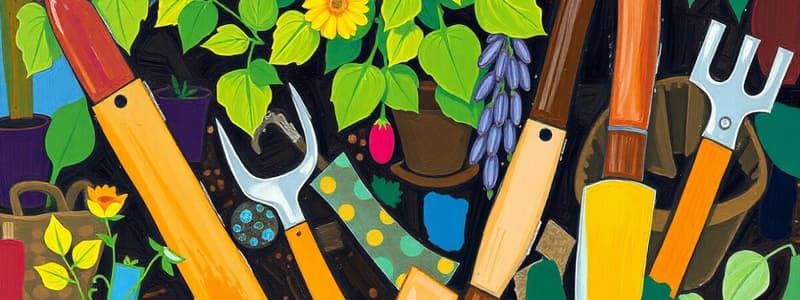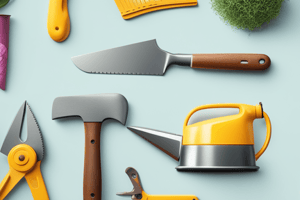Podcast
Questions and Answers
What is a hand trowel primarily used for?
What is a hand trowel primarily used for?
- Leveling soil.
- Watering large areas.
- Digging small holes and transplanting seedlings. (correct)
- Cutting thick branches.
Which tool is best for loosening soil and mixing in compost?
Which tool is best for loosening soil and mixing in compost?
- Garden shovel
- Garden rake
- Hand fork (correct)
- Watering can
What is the main purpose of gardening gloves?
What is the main purpose of gardening gloves?
- To protect hands from dirt, thorns, and irritants. (correct)
- To measure soil pH.
- To transport water.
- To cut small branches.
What is the function of a watering can?
What is the function of a watering can?
What is a garden hose used for?
What is a garden hose used for?
What are pruning shears (secateurs) used for?
What are pruning shears (secateurs) used for?
What is the primary benefit of using loppers instead of pruning shears?
What is the primary benefit of using loppers instead of pruning shears?
What is a garden rake mainly used for?
What is a garden rake mainly used for?
What is a garden shovel best suited for?
What is a garden shovel best suited for?
What is the main advantage of using a wheelbarrow in gardening?
What is the main advantage of using a wheelbarrow in gardening?
Flashcards
Hand Trowel
Hand Trowel
A small tool with a scoop blade for digging small holes and transplanting seedlings.
Hand Fork
Hand Fork
A tool with tines used for loosening soil, weeding, and mixing compost.
Gardening Gloves
Gardening Gloves
Protective wear for hands, shielding from dirt, thorns, and irritants.
Watering Can
Watering Can
Signup and view all the flashcards
Garden Hose
Garden Hose
Signup and view all the flashcards
Pruning Shears
Pruning Shears
Signup and view all the flashcards
Loppers
Loppers
Signup and view all the flashcards
Garden Rake
Garden Rake
Signup and view all the flashcards
Garden Shovel
Garden Shovel
Signup and view all the flashcards
Wheelbarrow
Wheelbarrow
Signup and view all the flashcards
Study Notes
- Gardening tools facilitate various gardening tasks, increasing efficiency and effectiveness.
- They range from manual hand tools to powered equipment.
- Each serves specific purposes in planting, cultivating, and maintaining a garden.
Hand Trowel
- A handheld tool with a pointed, scoop-shaped metal blade and a handle.
- Used for digging small holes, transplanting seedlings, and scooping soil.
- Useful for planting in containers and flower beds.
Hand Fork
- Features a handle attached to several tines (usually three or four).
- Used for loosening soil, weeding, and mixing soil amendments like compost.
- Helps to aerate the soil in pots and garden beds.
Gardening Gloves
- Protective wear for hands while gardening.
- Protect from dirt, thorns, splinters, and potential skin irritants.
- Available in various materials like leather, rubber, or cloth, each suited for different tasks and conditions.
Watering Can
- A container with a handle and a spout, used to water plants.
- Design allows for a gentle, controlled flow of water.
- Essential for delivering water directly to the base of plants without causing damage.
Garden Hose
- A flexible tube used to transport water from a source to the garden.
- Often made of rubber or plastic and can be fitted with various nozzles for different spray patterns.
- Used for watering large areas or plants that require a lot of water.
Pruning Shears (Secateurs)
- Handheld cutting tools with two blades that pass closely against each other.
- Used for pruning small branches, deadheading flowers, and shaping plants.
- Come in two main types: bypass (scissor-like cutting) and anvil (one blade cuts against a flat surface).
Loppers
- Similar to pruning shears but has longer handles for increased leverage.
- Used for cutting thicker branches that are beyond the capacity of pruning shears.
- Helpful for reaching higher branches without a ladder.
Garden Rake
- A tool with a long handle and a head with metal or plastic tines.
- Used for leveling soil, removing debris like leaves and twigs, and preparing seedbeds.
- Available in different sizes and tine shapes depending on the task.
Garden Shovel
- A tool with a broad blade attached to a handle, used for digging, scooping, and moving materials.
- Blade can be rounded or pointed, depending on the intended use.
- Used for tasks such as digging holes for planting trees, moving soil, and edging garden beds.
Wheelbarrow
- A one-wheeled cart with handles, used for transporting heavy or bulky materials.
- Helpful for moving soil, compost, plants, and tools around the garden.
- Saves time and effort compared to carrying materials by hand.
Hoe
- A tool with a flat blade attached to a long handle, used for weeding, cultivating soil, and creating furrows.
- Used to remove weeds from the surface of the soil and to break up compacted soil.
- There are different types of hoes, such as the draw hoe and the scuffle hoe, with each designed for specific tasks.
Soil Testing Kit
- A kit used to analyze the nutrient content and pH level of soil.
- Helps determine if the soil is suitable for growing specific plants.
- Usually involves collecting a soil sample and using chemical reagents to test for nutrients and pH.
Compost Bin
- A container used to collect and decompose organic matter, such as kitchen scraps and yard waste.
- Creates nutrient-rich compost that can be used to improve soil quality.
- Available in various sizes and designs, from simple open bins to enclosed tumblers.
Plant Labels
- Markers used to identify plants in the garden.
- Can be made of plastic, wood, or metal and labeled with the plant's name, planting date, or other relevant information.
- Help gardeners keep track of what they have planted and where.
Studying That Suits You
Use AI to generate personalized quizzes and flashcards to suit your learning preferences.




